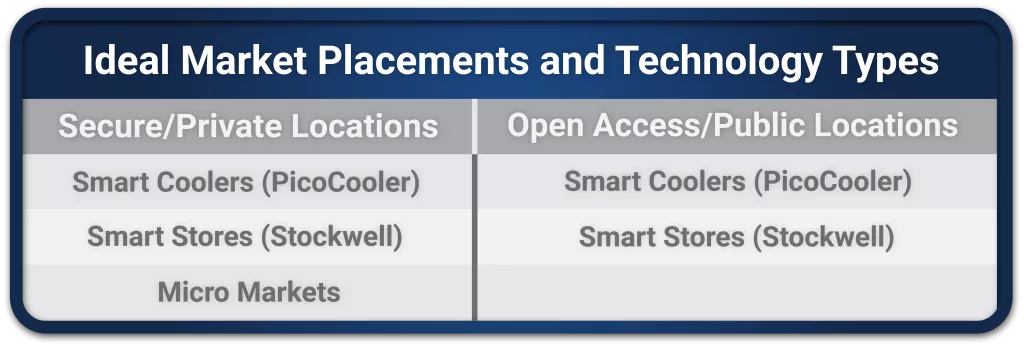Published • 24 Jan 2024
Vending Machines have ruled the unattended retail market for decades, however with recent technology and a fast-changing workforce, the unattended retail market has seen a new era dominated by Micro Markets.
And for good reason! Micro markets can lead to increased sales and better customer satisfaction. However, transitioning from vending to micro markets doesn’t happen overnight. Here are three things to consider before converting your vending machines to micro markets.
Return on Investment
While micro markets certainly generate more revenue than vending machines, they do tend to have a higher upfront cost. To compare apples to apples, let’s position a four-machine vending bank against a typical micro market. Let’s dive into the numbers:
Two drink vending machines and two snack vending machines can have an upfront cost of around $10,000. To set up a full-size micro market with a full-size kiosk, your upfront cost could be around $12,000.
For a vending setup, data shows that the average customer spends around $7 a month. With micro markets, an average customer spends around $20 a month.
Over a full month, revenues for the vending setup are $1,200. With our micro market setup, those revenues are $4,000.
From here, we can calculate our breakeven point. With the monthly profits vs. initial investment and operating costs, you can expect to break even with four vending machines in about 17 months. To break even with a micro market, it will take you about 7 and a half months.
Let’s take our profit figures and extend them over a year. Your expected annual gross profit from the vending machine setup is $4,800 / per year. With a micro market, your annual gross profit will be around $19,200.
In this scenario, micro markets clearly have an increased upfront cost, but a much higher earnings potential.
Account Factors
Vending machines are locked and secure, whereas micro markets are an open, honor-system based setup. Therefore, micro markets often don't work in public locations. Instead, you’ll have to put them in secure environments with little in and out traffic, like manufacturing facilities or offices. Another consideration when placing a micro market is the size of your account. How many employees does the account have? Ideally, the best micro markets are in locations of 250+ people, but they can work in areas with as few as 75. Plus, you’ll need a larger space and an internet connection when placing a micro market. So, before you jump into markets or convert a vending setup to a micro market setup, make sure you have the right location first.
Logistics
When examining vending machines, routine service is relatively straightforward. You have a limited number of spirals, which means few products. With limited products, stocking a vending machine can be very quick.
Micro markets on the other hand can have hundreds of SKUs. More SKUs means more products in your warehouse, more time spent servicing the micro market, and other increased service costs.
Plus, fresh food like salads, sandwiches, and juices tend to perform well in markets, which means you’ll have to keep a careful eye on safe storage and expiration dates.
On the other hand, vending machines tend to have more technical issues, whether that be from spiral issues to full-on breakdowns. With micro markets, breakdowns are less frequent.
You need to ensure your infrastructure is ready to handle a micro market before jumping into them. Consider factors like warehouse space, new product suppliers, service frequency, and more.
Micro markets are undoubtedly more profitable than traditional vending machines. As they continue to dominate the unattended retail space, high-value accounts will expect that their operators can offer them if needed. But before you get started, you need to consider the upfront investment, account type, and internal logistics to properly run a micro market business. Interested in learning more? Contact 365 Retail Markets today.
